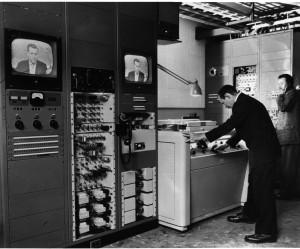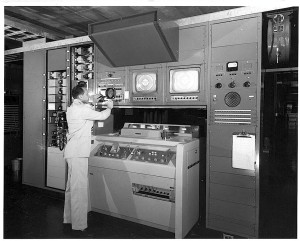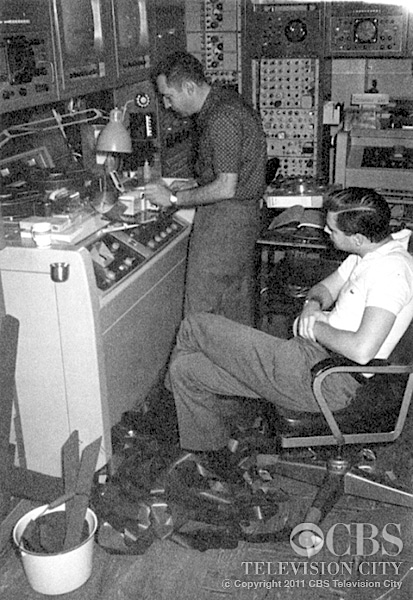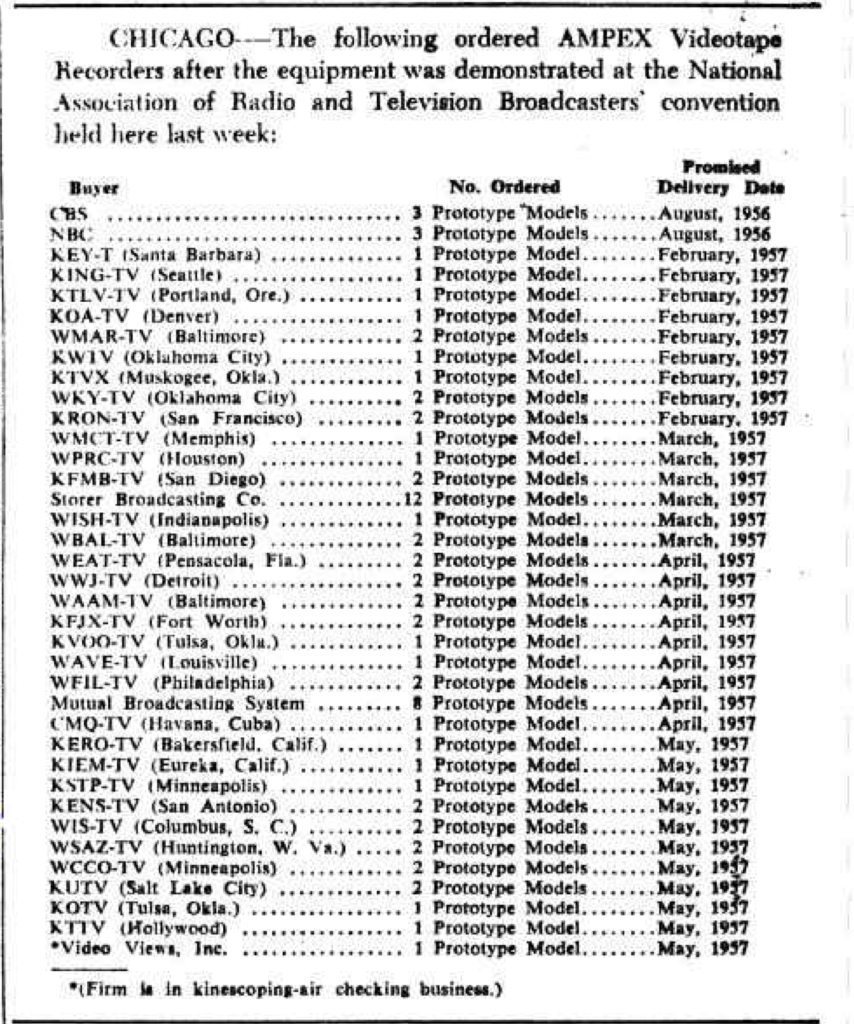It was 59 years ago November 30 that viewers of the dozen CBS Television Network Pacific Coast stations saw the first widely documented on-air use of Quad videotape for presentation of a regularly scheduled program: The playback of the CBS flagship news broadcast, “Douglas Edwards with the News” as recorded live off the transcontinental network line from New York at 4:15 p.m. Pacific time, 7:15 p.m. in the East.

Did Edwards report the first use of videotape by the network?
I say “widely documented” because this is the event Ampex promoted world-wide.
Whether there were other un-announced uses is likely known to only engineers and network officials who may have passed on without documenting those unannounced playbacks. (IE: “Let’s briefly switch from the kinescope to the videotape to see what difference it makes in Seattle.”)
This delayed broadcast at 6:15 p.m. on November 30, 1956 originated from CBS Television City in Hollywood from one of the two handbuilt Ampex VRX-1000 Quad recorders supplied to CBS. Both machines were recording the network feed from New York and while the Dec., 1956 edition of the “Ampex Playback” newsletter doesn’t say so, it’s likely that both machines were playing back their respective recordings as protection from a fault on the “On-Air” machine.
The on-air use followed the unveiling of Ampex’s “Mark IV” prototype at the National Association of Radio and Television Broadcasters (NARTB, now NAB) in April of 1956, and ushered in the beginning of “Time Zone Delay” for West Coast television broadcasts, and the development of other uses for videotape in production of programs.
Ampex reported orders for 80 machines representing $4-million, according to the April 18, 1956 Billboard magazine.
CBS and NBC were to be the first recipients of the Ampex VTRs as noted in this Billboard graphic accompanying the story:
CBS and NBC made big use of Videotape during (and after) President Dwight Eisenhower’s public second inauguration on Monday, January 21, 1957. They replayed the ceremony several times, and “heralded the first use of videotape” according to Television Histories: Shaping Collective Memory in the Media Age, edited by Gary R. Edgerton and Peter C. Rollins.
In this way, Eisenhower became the first US President to be videotaped, and would become the first President to be videotaped in Color a little over a year later during the dedication of NBC’s then-new facility housing WRC-TV/AM/FM/NBC News, Washington, DC.
See http://www.quadvideotapegroup.com/restoring-the-earliest-known-color-quad-tape-the-dedication-of-wrc-tvnbc-washington-dc/ for details and a link to video on-line.
Editors Edgerton and Rollins note that CBS used videotape to pre-record “Arthur Godfrey’s Talent Scouts” in late February, 1957 so the show remained on the network’s highly rated Monday night schedule while Godfrey was in Africa “on safari.”
By early 1958, CBS was operating a million-dollar videotape facility at its Grand Central Terminal technical center. Billed as the largest of its kind, the NY center and TVC in Hollywood soon were serving recorded programs to more than half the CBS viewers, according to papers on the IEEE website.

CBS’s “Playhouse 90” anthology series would be one of the programs magnetically recorded for both time zone delay, and for production.
The program debuted in October, 1956 just before CBS began delaying the Edwards’ broadcast.
By 1957, the show was being time-zoned delayed on videotape instead of kinescope, and videotape was being used in production.
By the start of the 1958 television season, ad agencies were moving live TV commercials to videotape.
Ad and program production initially centered at network facilities. In New York, CBS had 14 Ampex VTRs on line at Grand Central, NBC had two RCA Color and two Ampex monochrome recorders in Rockefeller Center and a dozen Ampex units in Burbank. ABC had six Ampex units in New York, six in Chicago and six in Hollywood.
CBS lays claim to (some of?) the first edited videotape productions, beginning with the April 19, 1958 intended colorcast of “The Red Mill,” an adaptation of Victor Herbert’s 1906 play. Delbert Mann directed the “DuPont Show of the Month” but I can’t find any editor or editors credited.
Television historian Albert Abramson’s “History of Television, 1942-2000,” has a footnote for Chapter 5 (#52) which states that CBS Television executive Joseph Flaherty, Jr., “claims that CBS did “The Red Mill” in 1957 with 168 edits in the 90- minute program.” I haven’t found corroborating information, yet.
Connecticut newspaper “The Bridgeport Post” reported a day before the broadcast: “TAKING NO CHANCE CBS-TV is taking the unusual step of putting “The Red Mill” on videotape. It will be the first major production taped-in-advance. This will necessitate a shift from color to black and white. The move comes because of the current strike of IBEW technicians. The program is scheduled for tomorrow night and if the strike should be settled by that time the show will reach the home screens live as originally planned.”
The September 29, 1958 issue of Broadcasting Magazine explains more, in a feature about ad agencies moving live commercials to tape.
BBDO ad agency executive Al Cantwell told Broadcasting that the production was much too complicated to be handled live by network executives who suddenly found themselves manning cameras, booms and lights. So it was taped in pieces and then edited together, a “thing never done before or since,” according to Cantwell.
Each point where sequences were spliced together had seven seconds of black. The alternate to the black was “roll over” on home screens. Although ways were found to shorten the black somewhat, it was decided to eliminate the black and take the roll over.
Larry Weiland’s November, 1986 American Cinematographer article “The CMX 600 Belongs to History” reports that, “Even while Ampex was developing its electro-mechanical splicing system, CBS engineers were experimenting with tape editing by shooting program segments with fades at each end, and splicing the tape in the “black,” hoping the VTR would re-synchronize during the fade up for the next scene. The first show, a drama called “The Red Mill,” was edited and recorded on two separate reels, one with splices in black, the other in picture. The two VR1000’s were run back-to-back. If the splice in picture went through the VTR without a serious image breakup, it stayed on the air. …
Playhouse 90 director John Frankenheimer was beginning to use the new magnetic medium for production.
As the Wisconsin Center for Fim and Theater Research notes in webpages about the anthology series, Playhouse 90’s stories often called for special effects-heavy sequences that made great demands on the technology of live television. The show quietly began using the new technology of videotape, first for individual scenes but eventually for entire shows. Indeed, nearly half of the episodes were in fact broadcast “live-on-tape” rather than truly “live.”
Frankenheimer had used videotape inserts rolled into two previous Playhouse 90’s: “Bomber’s Moon” and “The Days of Wine and Roses,” according to Bobby Elerbee’s “Eyes of a Generation” television history pages.
But the director saw editing videotape as the only way to bring together one of most difficult Playhouse 90 productions: A November, 1958 adaptation of William Faulkner’s “Old Man.”
The production involved creating a flood in TVC studios for the flood scenes, and was the first use of editing video tape to assemble a broadcast whose segments were shot at different times. See these CBS photos on the CBS Television City website:
The razor-bladed results aired on November 20, 1958, directed by John Frankenheimer (seated) and edited by Ross Murray (standing at the Ampex VR-1000 preparing an edit using a splicer.) CBS Photo (by Art Garza, according to Albert Abramson’s “ History of Television, 1942-2000,” which has another shot from the same angle showing Murray playing back an edit for Frankenheimer.)

Murray was at one time or another, an extra, dancer and stand in in movies before World War II, then a pilot and bombardier trainer before joining CBS Radio editing sound effects and later writing mysteries for radio.
An unplanned move to a 6 a.m. television show led to concentrating on developing the editing department at Television City with three other engineers. That led to the collaboration with Frankenheimer on “The Old Man.”
Abramson’s book notes that “Murray volunteered to cut the show together, even though such a job had never been done before and he had nothing but the Ampex Edit Block and a can of (Edivue) to show where the edit points were.”
The show contained 61 edits, and pulled together a 90-minute broadcast from eight hours of content videotaped over four days at Television City.
Murray turned 97 on Sept. 16, 2015, and is living in the small California Coast Range town of Boonville, between Ukiah and the coastal town of Elk.
Frankenheimer talks about directing Playhouse 90 in this clip from the Archive of American Television:
The clip and other Playhouse 90 information is found here: http://www.emmytvlegends.org/interviews/shows/playhouse-90#
While CBS was developing uses for videotape beyond Time Zone Delay, NBC was also building on videotape technology to bring business into its Burbank “Color City” studios, and by 1959, had elevated production technology and techniques to include keyed titling, chroma-key and the development of a process to allow razor-blade editing of shows to be as precise as film.
That process using a combination of videotapes transferred to 16mm kinescopes, sprocketed magnetic sound, and a talking clock called “Editor’s Sync Guide.”
The “ESG” process resulted in a lot of work for NBC Burbank, and awards for the editors who crafted the shows, first on film, and then by rolling through Quad videotapes to match the video edits to the film cuts. One might call it the television version of “Negative matching.” Examples of the end product range from 1959’s “An Evening with Fred Astaire” to “Rowan and Martin’s Laugh-In” which made a staple of many quick cuts between short clips, often just long enough for someone to say, “Sock it to me!”
In about five months, the 60th anniversary of the unveiling of Quad videotape will have just passed as the NAB Show opens in Las Vegas April 18, 2016.
A vintage surprise may show up if restoration is successful. Stay tuned for details as they become available.
Elsewhere, a well-regarded videotape equipment refurbisher anticipates having a restored Ampex AVR-2 working in Lower South Hall.
Other examples of the range of videotape—analog and digital—will be showcased among the increasingly smaller and higher resolution recording devices being exhibited. Long-time NAB attendees will either fawn over the older gear (or recall favorite curses) while newer generations may ask, “What the heck is that?”
Search the NAB Show website for “Videotape” or “Museum” as NAB gets closer.
Free exhibit pass code LV3654 can now be used for registration.
The Ninth Annual Quad Videotape Group Lunch at NAB will happen at 12:30pm, Tuesday, April 19, 2016 at a location to be determined. Last year’s venue has been eaten up by a sea of booths in Upper South.
Cheers from Chilly northern California.
Ted
Ted Langdell
Secretary

